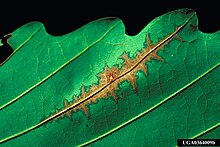
Sordariomycetes is a class of fungi in the subdivision Pezizomycotina (Ascomycota). It is the second-largest class of Ascomycota, with a worldwide distribution that mostly accommodates terrestrial based taxa, although several can also be found in aquatic habitats. Some are phytopathogens that can cause leaf, stem, and root diseases in a wide variety of hosts, while other genera can cause diseases in arthropods and mammals.
The fungal genus Truncatella in the family Sporocadaceae, and in the Amphisphaeriales order, includes plant pathogens such as Truncatella laurocerasi.

Pleosporaceae is a family of sac fungi. They are pathogenic to humans or saprobic on woody and dead herbaceous stems or leaves.

The Botryosphaeriales are an order of sac fungi (Ascomycetes), placed under class Dothideomycetes. Some species are parasites, causing leaf spot, plant rot, die-back or cankers, but they can also be saprophytes or endophytes. They occur world-wide on many hosts. For example, in China, infections related to Botryosphaeriales have been recorded on numerous hosts such as grapes, Caragana arborescens,Cercis chinensis, Eucalyptus, Chinese hackberry, blueberry, forest trees, and various other woody hosts.

The Amphisphaeriaceae are a family of fungi that is mainly found in parts of New Zealand, South America, Asia and parts of Europe. According to the 2007 Outline of Ascomycota, there were 41 genera placed within the family, although the position of 13 of those genera is uncertain. The 2020 Outline of Fungi and fungus-like taxa severely reduced the family to 4 members.

The Microascales are an order of fungi in the class Sordariomycetes, subclass Hypocreomycetidae. This is a relatively small order of mostly saprobic fungi that live in soil, rotting vegetation and dung. Some species are plant pathogens, such as Ceratocystis fimbriata, transmitted by beetles to living trees and causing cacao wilt and many other economically important diseases. Species in the genus Pseudallescheria are pathogenic to humans The order was circumscribed in 1980. Wijayawardene et al. in 2020 added more families and genera to the order.

Phyllachora is a genus of fungi in the family Phyllachoraceae. An Outline of Fungi in 2020 listed up to 1513 species.
Teratosphaeria is a genus of fungi in the family Teratosphaeriaceae; according to the 2007 Outline of Ascomycota, it was placed in the Phaeosphaeriaceae, but the placement within this family was uncertain. It was confirmed in 2020, within Teratosphaeriaceae by Wijayawardene et al. 2020.
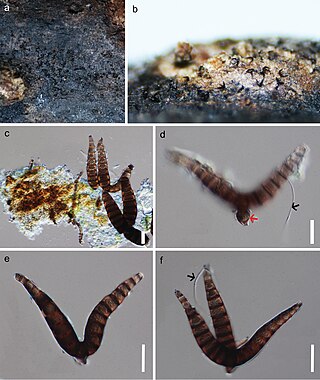
Iodosphaeria is a genus of fungi in the family Amphisphaeriaceae. Most of species of Iodosphaeria are saprobes that feed on dead leaves and twigs of various hosts such as the Argentine white pine. No species have been reported as pathogenic to hosts. As of January 2022, it contains eleven species.
Xenothecium is a genus of fungus in the family Hyponectriaceae; according to the 2007 Outline of Ascomycota, the placement in this family was uncertain. In 2020 it was confirmed. This is a monotypic genus, its only species being Xenothecium jodophilum. It was published by Franz Xaver Rudolf von Höhnel in Sber. Akad. Wiss. Wien, Math.-naturw. Kl., Abt. 1 vol.128 (7-8) on page 589 in 1919.
Caudospora is a genus of fungi within the Diaporthales order, class Sordariomycetes. It was later placed in the Sydowiellaceae family.

The Meliolaceae are a family of fungi in the order Meliolales. Mostly tropical in distribution, species in this family are biotrophic on the leaves and stems of plants. Despite this, most species do not cause extensive damage to the host plant, and are not generally considered to be of economic significance.
The Euantennariaceae are a family of fungi with an uncertain taxonomic placement in the class Dothideomycetes.
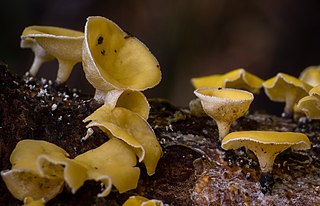
Lachnellula is a genus of fungi in the family Lachnaceae. The genus contains 40 species. Lachnellula was circumscribed in 1884 by Petter Karsten, with Lachnellula chrysophthalma assigned as the type species.
The Trichosphaeriales are an order of sac fungi. It is monotypic, and consists of the single family, the Trichosphaeriaceae. In 2017, the family of Trichosphaeriaceae was placed in Diaporthomycetidae families incertae sedis, which was accepted by Wijayawardene et al. (2018), and Wijayawardene et al. 2020. The order of Trichosphaeriales was also unplaced. They are generally saprobic and pathogenic on plants, commonly isolated from herbivore dung.
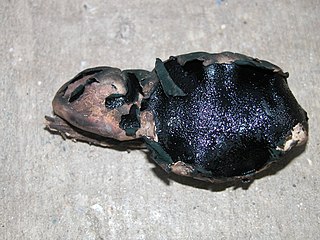
The Boliniaceae are a family of fungi in the Boliniales order. The family consisted of seven genera and 40 species in 2008. A new study found more genera and species in 2020.
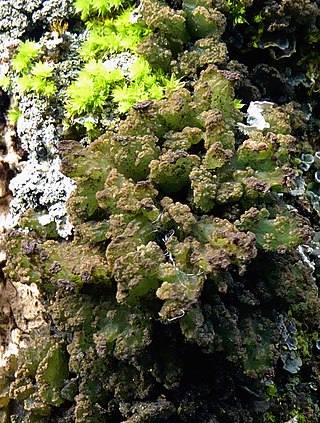
The Arctomiaceae are a family of lichenized fungi in the Ascomycota, class Baeomycetales. The family was named by Theodor Magnus Fries in 1861, with Arctomia as the type genus. Species in this family are found in arctic and subarctic habitats, usually associated with bryophytes.

The Magnaporthales are an order of fungi within the class Sordariomycetes and subclass Diaporthomycetidae. It has several water based species and genera.
Cameronia is a genus of crustose lichens in the monotypic family Cameroniaceae. It has two species. Both the genus and its two species were described as new to science in 2011 by Australian lichenologist Gintaras Kantvilas. Characteristics of the genus include its chlorococcalean photobiont partner, and perithecioid ascomata that are deeply immersed in the substrate. Microscopic features of Cameronia include the four-spored asci with an intensely hemiamyloid outer wall and non-amyloid, well-developed tholus, and hyaline, muriform ascospores. Both species are endemic to the Tasmanian Highlands.
Savoryellaceae is a family of aquatic based fungi. It is the only family in the monotypic order Savoryellales within the class Sordariomycetes, division Ascomycota.
